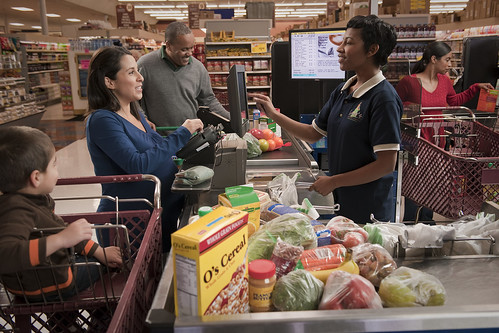
This post is part of the Science Tuesday feature series on the USDA blog. Check back each week as we showcase stories and news from the USDA’s rich science and research portfolio.
Achieving a good diet requires access to nutritious food, but it also requires good choices from among the many thousands of products available at grocery stores and other food retailers – a real challenge for consumers. How can we shape a store environment that makes healthy choices easier?
Researchers working with the Food and Nutrition Service recently conducted a thought experiment to encourage healthy purchases in the Supplemental Nutrition Assistance Program (SNAP). The researchers asked a number of leading experts to imagine a labeling system in place that clearly identifies the healthiest options in the stores, and develop strategies to promote them, especially for shoppers with limited resources. The strategies had to be feasible, sustainable, cost-effective, and appealing to all stakeholders: food manufacturers, food retailers, and consumers. The study team first identified key characteristics of labeling systems -- including the need to inform consumers without requiring complex interpretation, and to align with retailers’ and manufacturers’ competitive strategies and business practices.
With these considerations in mind, the team outlined six strategies to use a labeling system to encourage healthy choices. Some were financially-focused, providing a rebate back for every SNAP dollar they spent on healthful items, effectively reducing the price of these foods. A different approach encouraged retailers to offer 2-for-1 deals on healthy products or on pairs of healthy items that often go together (for example, healthy cereal and bananas). These kinds of promotions are commonly used and proven effective, but often promote less healthy products in the store.
Another new take on a common approach is the suggestion to utilize manufacturer coupons for the healthiest items, providing them directly to SNAP recipients. A more novel idea is to develop a reward card that could be used across retailers to allow SNAP participants to earn “points” when they purchase healthy items and also access additional discounts.
The study team also suggested two nonfinancial strategies: a visual shopping cart tool and the use of targeted merchandizing and product promotion. The shopping cart would build on the success of USDA’s MyPlate to translate the visual guidance to make half your plate fruits and vegetables into the retail environment. It would provide a visual cue to consumers to fill their cart with more fruits and vegetables, whole grains, low-fat dairy and lean proteins. The targeted merchandizing approach builds on practices that retailers have been honing for decades to highlight products in a way that catches the attention of consumers. By applying these strategies to healthy products, retailers could, at fairly low cost, help to make healthy items easy choices for everyone in the store.
FNS has recently released the full study report, Approaches for Promoting Healthy Food Purchases by SNAP Participants, which describes each of these approaches, and provides additional detail on the discount coupon and the targeted merchandizing approaches. The report also lays the groundwork for conceptualizing how these approaches could be tested in the field in the future.



